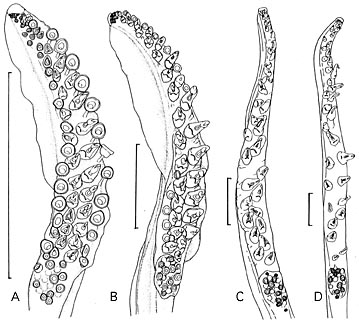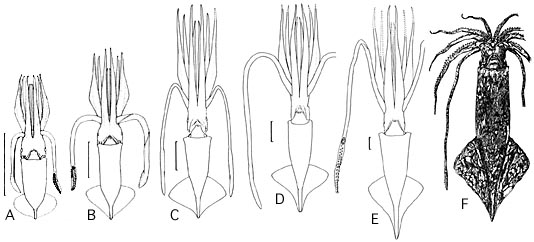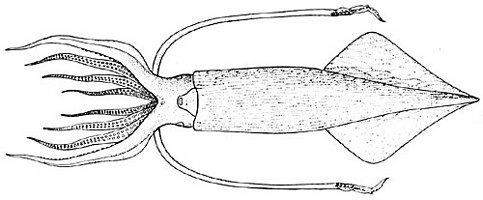Onykia (Onykia) robusta
Michael Vecchione, Richard E. Young, and Kotaro TsuchiyaIntroduction
O. robusta is the type species of the former genus Moroteuthis and largest species of the genus. It reaches a length of at least 1615 mm ML (Kubodera, et al, 1998). This species is found only in the high North Pacific.
Diagnosis
An Onykia ...
- with sagittate fins (fins drawn-out posteriorly).
- with ridges rather than warts on skin.
Characteristics
- Tentacles
- Club with 15-18 pairs of hooks.
Scanning electron micrographs of the hooks can be seen here.
- Suckers of marginal series absent at greater than 61 mm ML.
- Club with 15-18 pairs of hooks.
- Head
- Beaks: Descriptions can be found here: Lower beak; upper beak.
- Beaks: Descriptions can be found here: Lower beak; upper beak.
- Mantle
- Dermis of mantle skin with longitudinal ridges.
- Fins
- Sagittate shape beyond 94 mm ML.
- Length 50-65% of ML.
- Width 60-70% of ML.
- Gladius
- Rostrum 25-40% of GL; opaque, circular in cross-section.
comments
Additional features of the description are found here.Nomenclature
O. japonica (Taki, 1964) and O. pacifica (Okutani, 1983) are junior synonyms (Tsuchiya and Okutani, 1991).
Life History
At less than 43 mm ML, the mantle has an irridescent epidermis overlying numerous indistinct ridges; at 61 mm ML, the mantle surface has fleshy ridges and a weak iridescence; at 94mm ML no iridescence remains. The shape of the fins changes greatly with growth from oval in combined outline at less than 20 mm ML to saggitate in adults. The rostral cap is 20% of the ML at 43 mm ML and 30% at 100 mm ML. The inverted Y-shaped ridge is detectable in specimens larger than 60 mm ML. By 61 mm ML all marginal suckers on the club are absent. This life history data is from Tsuchiya and Okutani, 1991.


Figure. Development of the tentacular club of O. robusta. A - 19.4 mm ML. B - 42.8 mm ML. C - 60.5 mm ML. D - 135 mm ML. Scale bar is 10 mm.
Changes in body proportions with growth have been illustrated by Tsuchiya and Okutani (1991).


Figure. Ventral views of O. robusta at various sizes. A - 19.4 mm ML. B - 42.8 mm ML. C - 60.7 mm ML. D - 135 mm ML. E - 181 mm ML. F - 1615 mm ML. Scale bar = 2 cm. Drawings from Tsuchiya and Okutani (1991, p. 139).
Changes in body form are reflected in changes in the shape of the gladius.
Distribution
This species is found in the temperate to boreal North Pacific (Kubodera, et al., 1998)Other Names for Onykia (Onykia) robusta
- Moroteuthis robusta
- Ommastrephes robustus
- Onykia japonica
- Onykia pacifica
References
T. Kubodera, U. Piatkowski, T. Okutani and M.R. Clarke. 1998. Taxonomy and Zoogeography of the Family Onychoteuthidae (Cephalopoda: Oegopsida). Smithsonian Contributions to Zoology, No. 586: 277-291.
Tsuchiya, K., and T. Okutani. 1991. Growth Stages of Moroteuthis robusta (Verrill, 1881) with the Re-evaluation of the Genus. Bulletin of Marine Science, 49(1-2):137-147.
Title Illustrations

| Scientific Name | Onykia (Onykia) robusta |
|---|---|
| Location | Eastern North Pacific off Monterey, California at 36.97°N, 121.85°W |
| Comments | In situ photograph of O. robusta taken at a depth of 290 m. |
| Acknowledgements | Image courtesy of the Monterey Bay Aquarium Research Institute (MBARI). You must obtain permission from MBARI to use this photo; please contact pressroom@mbari.org for further information. |
| Specimen Condition | Live Specimen |
| Identified By | R. E. Young |
| View | Side |
| Size | Unknown |
| Copyright | © 2013 MBARI |
About This Page
Figures from Tsuchiya and Okutani printed with the Permission of the Bulletin of Marine Science.

National Museum of Natural History, Washington, D. C. , USA

University of Hawaii, Honolulu, HI, USA

Tokyo University of Fisheries, Tokyo, Japan
Page copyright © 2013 , , and
 Page: Tree of Life
Onykia (Onykia) robusta .
Authored by
Michael Vecchione, Richard E. Young, and Kotaro Tsuchiya.
The TEXT of this page is licensed under the
Creative Commons Attribution-NonCommercial License - Version 3.0. Note that images and other media
featured on this page are each governed by their own license, and they may or may not be available
for reuse. Click on an image or a media link to access the media data window, which provides the
relevant licensing information. For the general terms and conditions of ToL material reuse and
redistribution, please see the Tree of Life Copyright
Policies.
Page: Tree of Life
Onykia (Onykia) robusta .
Authored by
Michael Vecchione, Richard E. Young, and Kotaro Tsuchiya.
The TEXT of this page is licensed under the
Creative Commons Attribution-NonCommercial License - Version 3.0. Note that images and other media
featured on this page are each governed by their own license, and they may or may not be available
for reuse. Click on an image or a media link to access the media data window, which provides the
relevant licensing information. For the general terms and conditions of ToL material reuse and
redistribution, please see the Tree of Life Copyright
Policies.
- First online 23 June 2003
- Content changed 08 January 2013
Citing this page:
Vecchione, Michael, Richard E. Young, and Kotaro Tsuchiya. 2013. Onykia (Onykia) robusta . Version 08 January 2013 (under construction). http://tolweb.org/Onykia_%28Onykia%29_robusta/19976/2013.01.08 in The Tree of Life Web Project, http://tolweb.org/












 Go to quick links
Go to quick search
Go to navigation for this section of the ToL site
Go to detailed links for the ToL site
Go to quick links
Go to quick search
Go to navigation for this section of the ToL site
Go to detailed links for the ToL site